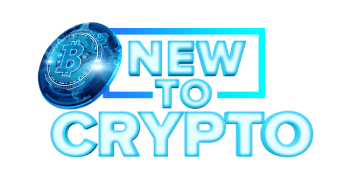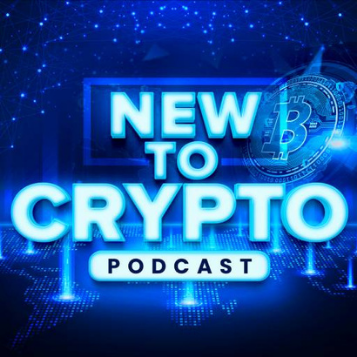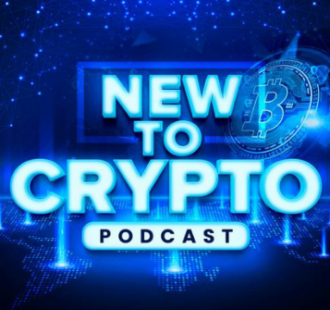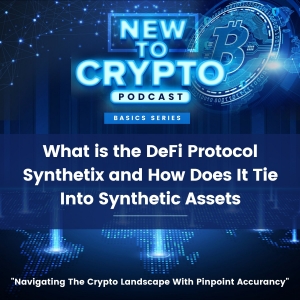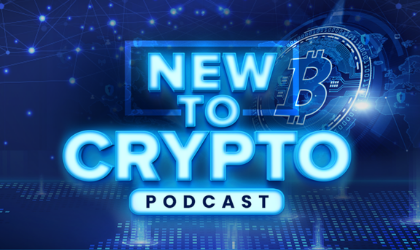Michael 0:01
Welcome to the New to Crypto Podcast designed to guide you through the crypto landscape with pinpoint accuracy created for the new and intermediate crypto investor. Join your host Crypto Travels Michael as he takes you through the different facets of getting started and succeeding in your crypto journey. New to crypto podcast brings you new episodes daily Monday through Friday with surprise bonus episodes sometimes on the weekend. Let me ask you, are you new to crypto and don’t know where to start? Are you more experienced but have questions? Then you’re in the right place. This podcast is designed for you coming at you from the Trading Center and the Lifestyle Dezign Studio. Here’s your host Crypto Travels Michael.
Brave wallet is the first secure crypto wallet built natively in a web three crypto browser, no extension required. You can store, manage and grow your portfolio, get NFT’s and multi chain support, download the brave privacy browser at brave.com/newtocrypto and click on the wallet icon to get started.
Today’s interview is about a hot new project which incorporates gaming prediction markets and their own liquidity engine. I have Philipp and Ivan here to tell you all about Nezha which could be a game changer in DeFi and gaming. Philipp and Ivan. It’s a pleasure to have you here. Welcome to the show.
Philipp 1:31
Thank you. Pleasure to be here.
Ivan 1:33
Thank you, Michael. Delighted to be on.
Michael 1:36
Hey, absolutely, guys, hey, before we dive in, can you give us just a little background on yourselves? On each of you?
Philipp 1:42
Sure, let me say that first serial entrepreneur across a variety of spaces. But focusing mainly on sports in the traditional side of prediction markets lately, mainly, on the US and Canadian side, I’ve been a crypto investor for the past few years learning about a variety of ecosystems mainly focused on Solana and Cordano.
Ivan 2:02
So I’ve spent 20 years in technology, built the trading platforms for IG and ran a team of engineers that grew to 250 in a global leading trading business. And then I ran a competitor or capital.com, and founded a cryptocurrency Exchange, or currency.com. And I’ve been investing quite heavily in DeFi projects over the last year playing advisory roles. And when Philip and I came up with this idea, we decided to dive in and start something together.
Michael 2:35
Wow, guys, talk about a phenomenal experience for both of you. By the way, I’ve used both currency and capital. You know, I have accounts on those as well. But, guys, before we dive into all the details of your project, can you give us just a little overview about Nezha? And what is it for our listeners?
Philipp 2:55
Sure. Nezha is what we refer to as the next generation prediction markets. As we work on turning a market that’s traditionally a zero sum environment into a positive sum environment. And so what do we actually mean with that, when you look at the traditional set of prediction markets, it tends to be games in which one of the parties has to lose for the other to make a prediction and for one party to win and the other has to lose and and vice versa. And this is a market environment in which there’s a lot of fun, but it creates a lot of inherent challenges that we’re trying to address with this protocol. So the way that Nezha operates is that all of the participants of a market provide liquidity together into one central staking pool and to be able to participate in the game you have to be part of that pool. But if you’re part of that pool, you can make a prediction on any of the given games that we’ll be launching. And recall that such will aggregate liquidity across the five to generate a return. And it’s only this return as being distributed according to the prediction market outcomes. So what we’re able to do is for any participants to forfeit their staking rewards in order to be able to stay. And then all of the staking rewards from the entire community together can be distributed to very few winners, thereby creating these dynamics of really outsized gains and very short amounts of times and a game of fine way and without anybody really having to lose, because the liquidity that you provide remains locked in the second contract at all times.
Michael 4:20
Wow, a lot is going on with Nezha. And for our listeners, we’re actually going to break down and unpack things in a more detailed way. And that brings me to my next question for you both is what is the liquidity engine and what solutions does Nezha provide?
Philipp 4:36
So a liquidity engine means that we are collecting liquidity from our community, and we’re optimizing where that liquidity goes into the market to generate a return. So liquidity is simply the amount of crypto stake within our protocol. Nezha will support USDC as a launch currency which is a stable coin, and we will make sure that this stable coin is allocated across the defined space in a way that optimizes risk and return. And so the liquidity engine in this case is kind of a business to business component in which we will use the liquidity that our community gives us and invest that on their behalf in order to create an optimal return for the games on the platform.
Michael 5:16
Okay. And let me ask you what our prediction markets are because I was going over your project, and can you share with our listeners what a prediction market is, maybe in a simplified way for them?
Philipp 5:30
On a very basic level, a prediction market is an environment in which you’re trying to predict anything. So there’s a variety of traditional prediction markets, they can be event based, it can be family based, there’s a whole ecosystem around it in terms of you making a prediction. But essentially, you’re going out there and you’re saying, I think this will occur. And then based on one event, we’ll see whether this does occur. So this could be a variety of things. Traditionally, it’s the known as number combination, or sporting events, or how the weather will be in the sort of wave of prediction markets 1.0 that we’ve seen on the blockchain, which was a couple of years ago, a lot of it revolved around where will the price of Bitcoin be in one hour, two hours. And this was sort of the very first stage of prediction markets where it was just about do I think something will go up? Or do I think something will go down? And now these are games that introduce a variation on this with a very different functionality? And I’m sure we’ll touch on that.
Michael 6:29
Okay. And I wanted to ask you, who are the target users for Nezha? Like, you guys designed a phenomenal project, and who is it… Like… specifically designed to target, to help.
Ivan 6:41
So I think when you talk about prediction markets, and gaming and entertainment, I think a lot of people that we’ve spoken to shy away from some elements of the traditional prediction markets, where you know, they know the realities of going against the house or wagering something might happen, where where you’re actually staking money that if you don’t win, you lose, right. And so there’s a whole audience of people there that are probably a little bit nervous about what might happen if they get too caught up in the entertainment side of it. And they prefer to keep their cash, kind of in much safer areas of investment, and not gamble with their money. And the prediction market protocol that we’re building is much more aligned with the DeFi staking audience. So people when you’re staking for awards, and returns, you know, your capital is being deployed. And you know, one of the areas we can come on to when we look at the technology is how is that capital being secured and with the smart contracts, managing that and the audit process around that. But, you know, assuming that where you’re staking your capital is a safe, smart contract for it to be staked in, you will be entitled to receive that money back at some point in the future. And the way that we’re designing this game is so that you stake money in the protocol for a period of time in order to be eligible to participate. But at any time you can undertake and then, you know, no longer participate going forward. So we feel like this will appeal to the audience of people who are already staking for a return, we feel like there’s an element of their assets that they would like to have some exposure to a potentially very large return in a short space of time without risking the capital of their assets.
Michael 8:35
Okay, excellent. And actually wanted to go over one of the major benefits is you’re gonna launch a revolutionary game. Can you guys tell us a little bit more about that?
Philipp 8:44
Yeah, definitely. So the first thing that we’ll be launching, it’s called Nezha Draw. It’s called the Nezha Draw, because at its core functionality, out of a set of numbers, we’ll be drawing six numbers each week. And so the prediction in this case is that every participant in the prediction market will try to predict ahead of time, what the sequence of six numbers will be in any given week, and there’s a mathematical probability to this happening. And so where it can be controlled, you know, how many participants in the game who’s got one chance of winning it. And so what this allows us to do is create a fully transparent and fair market environment in which however much you invest, you can have a chance at this current price. And depending on how much liquidity you put in, you might have a slightly larger chance than the less chance but we’ve really introduced a lot of these dynamics to make sure that it’s as fair as possible. And even if somebody introduces a very large amount of money to the project, that you have a as fair as possible chance of winning the overall thing. And so what happens in this case, and how the game is structured is the Nezha Draw structured epochs. Each epoch is a week long. That means that one week ahead of the actual draw occurring six times was being drawn, the staking closes, and you will have to have staking in the smart contract to be able to participate in the game. During the week-long process of the Nezha Draw, we’ll be working our magic generating yield across DeFi and making sure that there is a stable, but safe return. And then thereafter, the yield that has been generated over this entire week will flow back into one central price pump. And if there is a winner, so somebody predicted six out of six numbers correctly, they win this grand prize. And then there’s also a secondary third price here. So that if somebody’s got five or six numbers strength, or four out of six number strength, they will win the secondary or tertiary prize that is slightly smaller than the Grand Grand prize. And that’s how this works.
Michael 10:47
Awesome. Where did the idea come from, you know, to create the draw game? I think it’s an awesome idea and concept.
Philipp 10:54
Yeah, so we’ve spoken to a lot of people. And we’ve been trying to establish, you know, where do people get into entertainment and excitement from with the traditional standard prediction market? And the feedback that we were getting from the community was they liked the anticipation of guessing something and then seeing does it pays off, does it not? And so this is also really something that we’re trying to involve into the actual game. Whereas the numbers unveil, now we’re not just publishing the six numbers, here they are, there’s kind of like a little bit of a process, a little bit of event to it, where the numbers are available one by one, kind of match the numbers that you have on your card against the numbers that are happening. We’re trying to create this event of wrappers. But yeah, it’s really important for us that we build all of these games with community focus. And so that’s what we’ve been doing from day one trying to talk to people and understand what they find entertaining. And then from there, build something that hopefully matches the community’s expectations.
Michael 11:48
Awesome. And I see you’re launching on Solana, what’s the benefit of launching on Solana? Can you take us a little deeper about that?
Ivan 11:55
So, Solana has really emerged as a major contender, and you know, who’s gonna win the race here? Right. And I think, you know, I’m not particularly religious on one chain over another. I think there’s space for innovation here. And, you know, there’s maybe 10 Big layer ones now that are emerging over the coming couple of years. But I think, you know, people are very aware of the ET H gas fees. People have seen the scalability and performance of Solana. I think Solana has really captured a lot of the gaming community. We’ve had a really strong reception from people we’ve spoken to within the Solana ecosystem, be that yield generation platforms, launchpads, people that are participating in providing liquidity, and DeFi protocols. So I think, you know, different layer one blockchains have developed very strong allegiances and alliances in certain areas, and Solana just felt like a very natural fit.
Michael 12:52
Brave wallet is the first secure crypto wallet built natively in a web three crypto browser. What’s web three, web three is freedom from big tech and Wall Street. More controlling better privacy. But there’s a weak point in web three, your crypto wallet. Most wallets are browser extensions, or web to technology. That means the same old risks. App spoofing, phishing, scams and theft. Brave wallet is different. Brave wallet is the first secure wallet built natively in a web three crypto browser, no extension required. With Brave wallet, you can buy, store, send and swap assets, manage NFT’s even connect other wallets and dapps. All from the security of the best privacy browser on the market. Whether you’re new to crypto, or a seasoned pro, it’s time to ditch those risky extensions, it’s time to switch to brave wallet, download brave at brave.com/newtocrypto and click on the wallet icon to get started.
Michael 13:56
Definitely understand the awesome choice. Let’s talk about your token for a moment. And let’s go into the utility of your token: what is the name of your token? First of all.
Philipp 14:06
The token is NEZ. So kind of the whole platform is Nezha. And then in the short term, just the NEZis the token.
Michael 14:12
Okay, and can you unpack and break down like the utility of your token?
Philipp 14:16
Of course. So there’s two main components to it. We have a more consumer b2c focused part of it than a more business to business b2b focused side of the token and the token utility. On the consumer side of things. It’s important that people that are supporting us, the ecosystem (that is Nezha) receive a whole lot of benefits within the game center and the platform as such. And so by staking NEZ, we will be awarding different tiers depending on the amount of NEZ staked and depending on which tier you’re in will have varying degrees of benefits none of these games varying degrees of access rights than also as we launch more and more games, you will have early access or access to special games. and all of that. So we’ll pay a key and close attention to these supporting members and build out the ecosystem and make sure that we give back as much as we can. There’s also an element bear in which part of the revenues protocol generates will be dedicated to buying the token and burning it. So we’ve got a provision in place in the organization that states that as soon as the protocol is self-sufficient, revenues will be used to buy back the tokens on the available markets, destroy them forever, to reward those that were holding it, and to help create positive price development and pressure. And then there’s the b2b side of it. So we’re paying a lot of attention, and detailed attention here, building out a very entertaining and exciting product, working on the score while now we’ve got a really kick ass team working with it. And so we’re very confident that at some point, there will be alternative people that say, Hey, this is a fantastic game, I want to do something like it. And so instead of creating a market environment where people have to compete with us and are trying to create something like we do, and takes a lot of time takes a lot of planning, we wanted to create an efficient situation in which anybody could white label protocols such and could open up a game, like the ones that we’re creating. And the only thing that we ask is that, that user has to stake NEZ (A predefined amount of NEZ) to be able to access and white label these and sort of give access on their own platform to the technology that we’ve been creating. So that’s the sort of two core angles of utility behind NEZ.
Michael 16:34
Okay, and let’s talk about the DeFi component for a moment where staking, you know, is obviously made available, is there more that you can share with our audience about this staking component.
Philipp 16:45
Yes, so we’re working with a bunch of partners in the DeFi space, we’re currently in the final stages of unveiling our launch partner that we’re going with so stay tuned on our communication channels. So who that might be? Can’t come in, unfortunately, just yet. But the important part is that we’ll be working with different DeFi protocols built on Solana, and making sure that we supply liquidity to kind of create a return, that is good, but never too risky. So we’ve got a bunch of provisions in place on our side, to make sure that any of the parts that we’re working with have been fully audited, or safe liquidity that we’re providing is not a significantly large part of the pool that we’re staking into. And all of those things to create a stable but good return, that we can spread across the audience. And so as the protocol grows, we will be integrating with more and more partners across Solana. And you can think of this almost as being a gamified yield aggregator across Solana, where we’re taking the best parts from the different protocols, making sure they have the liquidity to function, but then we’re not just regenerating the return and giving it back to the audience or grabbing a gamification element of that where you can have fun with it without any gaps.
Michael 17:55
Okay. And I wanted to ask you guys under your protocol mechanisms, you mentioned prediction pools. Is there anything else that you want to share that is a little more deeper about prediction pools with our listeners?
Philipp 18:07
Yeah. So when the prediction pools one of the things that we’re keen on, and this kind of goes more, it’s in between the b2b and b2c, you know, was we’ve been really encouraged by people coming back to us, and a lot of the early supporters giving us suggestions for what type of game we should be developing, or, Hey, this is something that I love to see in this type of platform. So we’ve heard everything from sports, to pinball, to whatever. And it’s been, it’s been really heartening to see. And so one of the things that we’ll be building out is the opportunities for independent developers to integrate with this and actually create their own external markets to integrate with the infrastructure that we’re building below that. And so these prediction pools, as we call them, it’s the idea that, you know, you can set up your own pool if you have a great idea for a game, and you’ll be able to integrate with what we built to connect that game to the infrastructure on top of it, but we want to be realistic. That’s the medium to long term play. I think we’re a good few quarters out from that, because right now we’re laser focused on building out the first game, making sure it’s safe and functioning. And then we can devote proper attention to also unlocking this set of features.
Michael 19:13
Okay, and I see that Nezha is developing a list of mechanisms. Can you break down your ecosystem and what that looks like?
Philipp 19:20
Yeah, so we essentially have a variety of mechanisms within the overall ecosystem, it starts very simply, we’ve got a community member that stakes stable coins into our stake contract. And this liquidity is funneled onwards across different Solana to generate a return. Now this return is obviously being returned at the end of the epoch. And from there, it goes to different pools within the ecosystem. And this is kind of segmented into a roadmap where we start small and initially there’s very few points and then at some point, once the liquidity is there, and the total value is a bit higher, we will expand on that somewhat. So initially, it’s very straightforward. There’s a pool to reward those that have participated with these prizes. So the money goes back into the smart contract. And the smart contract understands, has there been a winner, was there a second prize and set your price. And then we’re working with an insurance provider to insure against this. And there’s some clever mechanisms involved, that’s making sure it’s all still stable. And so that’s being handled initially, as the protocol grows a bit, there are a few pools that are entering there. We mentioned previously, the buyback and burn pool, where as the protocol is able to sustain itself, we will be buying back currency and burning it is also a foundation tool. So the foundation was something where, you know, the reason that we’re creating this protocol essentially, is because we think that blockchain technology can invent really old space for the better. And it can do some fascinating things just by the power of technology. And so we’d like to open up the foundation to at some point to support others that’s striving for similar goals. And then obviously, there is an operational funk pool, because developers need to be paid, we want to reward those that contribute to the protocol. And there’s server fees, marketing fees, and all of that, which we’ve raised capital now from our fantastic investors to cover for this initial part of the protocol that at some point, this needs to become self-sufficient. And then the last one there in that ecosystem is the affiliate flywheel pool, which is something that we intend to introduce at a later stage as part of the growth of this protocol in which we would like to work with people that refer to their friends and other users, and that talk about the protocols. And we’d like to fully automate this in a way that part of the generated yields goes into that failure pool. And anybody that refers and brings a new user receives an automatic share of that pool. And depending on how many they bring their share would increase status to kind of survive functioning of the protocol. But everything is safe.
Michael 21:54
Fantastic. Yeah, I want to get into your stages right now. Let’s talk about your 2022. roadmap. I know you guys are doing things in stages. And in phases, can you share a little bit with the audience about what that looks like this year?
Philipp 22:06
Yeah, I mean, right now we’re laser focused on two things, we’re shortly had a variety of ideas that will occur in about two weeks on the proper finance platform on Solana. So that’s very exciting. And we’re really focused on making sure all of that is taken care of communicating with our community the right way, answering all the questions, and that the technical infrastructure around that is sound of beat Scott. And then afterwards, we’ll be continuing to build out the product. And let’s hope that we can introduce the product as soon as possible. Initially, we’re forecasting in the sort of very shortly after the idea, but as any technical project founder knows, is unfortunately lazy at some point, and so that we expect those who are uncertain or experienced those. And so, delays, there have been some small delays, we’re working hard to make sure that we can introduce the platform on Solana as soon as possible. And so that’s initially what we’re laser focused on, getting the platform life, getting it audited. And then for our roadmap in 2022, it’s important that we have it out and we make sure that we integrate as many DeFi protocols and Salon as possible. And then slowly, but surely, we’re working off and introducing more and more of these pools. So starting with full cycle, private pool, ciliate pool all of that, ahead of us really investing into more governance structure, which is a separate topic. We want to skip ahead here.
Michael 23:29
So what else would you like to share with our audience about what you guys have going on?
Philipp 23:34
So a whole bunch of things, I think. We’d like to draw some attention to the fantastic partners that we’re working with. So you know, the ideal platform that we’ve recently briefly mentioned is proper finance, and this is often a very exciting process for them. There’s been a defy protocol that’s been around for some time now in Solana, but they’ve just recently made the move to expand to becoming a launch plan. And so we’ll be the second ever protocol launch there, right after the setback protocol, which is exciting. And so we’d definitely like to draw some attention to what they’re up to, and it’s really worth checking out. And then also our first partner, I can announce the first question. So let’s ignore that one. I wish I could. But yeah.
Ivan 24:15
The other thing I think we could draw attention to Michael is, you know, I’ve had 20 years in building technology products for people and throughout building the trading platforms at IG, you know, going back to 2003 2002. You know, we’re building our first streaming mobile apps where you’re training, FX markets globally. sports books, markets globally. And, you know, really, I think we’ve assembled a fantastic team of people that really understand how to engage with users, how to run the focus groups, and how to do the UX testing. And I think in blockchain, we’ve seen a lot of, you know, the first generation of disruption coming into core infrastructure, the plumbing, and really, you know that there’s some platforms that are now being built on top of that, that are really interesting and engaging. And I think that’s an area that we’re really focused on is to create an entertaining product. And we want to take Solana to a broader audience. There are so many people out there that are, you know, throwing chips into a casino or, you know, spending money on a lottery. And, you know, we feel like there’s a lot of people still that don’t know about Solana, don’t know about blockchain, see it all as quite difficult, quite complicated. You know. So I think there’s a lot of people that can take to a product that is entertaining, that is challenging the status quo, and really helping to grow the blockchain community and go beyond its current boundaries.
Michael 25:48
It’s exciting what you guys have gone over Nezha, and everything you’re developing. Guys, I wanted to ask you who were the early supporters of the project?
Philipp 25:57
Yeah, we’re very, very grateful that we have strong support for the IMS and that has really helped us to get to the point where we are, and to get to the point beyond. Our initial investment prior to the ideal was led by some well known funds, including au 21, llama, OIG, Note seats, Stratusphere, and a whole bunch of other early investors that we’re very grateful to have on board. Specifically in the Solana system. We’ve had zbs capital and Coupon which are relatively niche. And since a lot of focus countries have been incredibly helpful in creating industry connections and pulling us into the space and learning with others around us.
Michael 26:41
Fantastic. You guys have had some really established supporters and backers of the project from early on. It’s an exciting time where you guys are going with this project and I’m excited to see a grand slam this year with all things Nezha. You know, in closing Guys, can you share with us about I know you have a global team and a team around the world? But you know, can you share with our listeners a little bit about your team?
Ivan 27:05
Yeah, sure. So we have, we’ve assembled a really innovative group of people that really believe in the project and bring together a range of different skills, we’ve got a very strong back end team, building out the smart contract layer with rust developers. We then have a UX and front end focus team that are doing all the prototypes and designs and now building those very actively to get our MVP live. And then we brought together a really strong community team, you know, actively engaging with our community on Twitter and Telegram and Discord. We’re just really engaging that discord community and building up to the idea, which is very exciting for us, you know, we’re getting beyond that initial concept and kind of product concept stage. And now it’s really becoming very real. And the audience is getting engaged and growing very actively. So, you know, Philipp and I are in very different time zones with me based in London and Philipp in Vancouver right now. And we have developers in a number of countries across Europe. And our CTO is based in London here with me. So it’s, yeah, it’s great.
Michael 28:17
I’m excited about your project and 2022 and beyond with everything that you’re doing in the Solana ecosystem and your own project. And Ivan and Philipp, it was a true pleasure and honor to have you here on the show today. And I welcome you guys back. Once you launch, we’ll have to bring you back to the show. And you can tell everyone to give everyone updates, guys. Fantastic, exciting.
Ivan 28:38
Thanks very much, Michael. Appreciate that.
Michael 28:40
Thank you. If you liked today’s episode, definitely like and subscribe to the podcast show your support and chime in here tomorrow for another special episode. Until then, make it a great day.
Thanks for tuning in to New to Crypto Podcast. If you liked the episode, be sure to follow and subscribe. You can listen to every episode on all major platforms to have an interest in being on the show or one advertising reach out at newtocrypto.io. Head over to our site newtocrypto.io to access the resources mentioned in each episode. Until next time, remember to navigate the crypto landscape with pinpoint accuracy.
